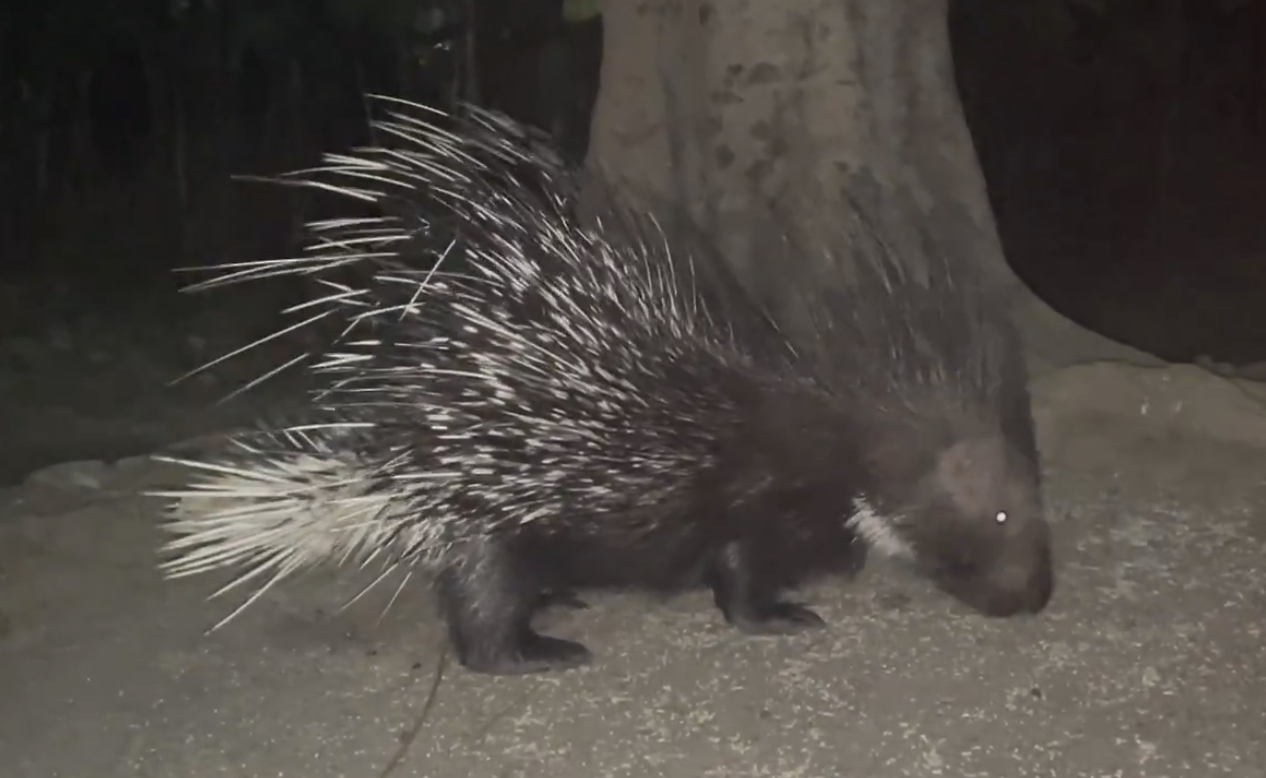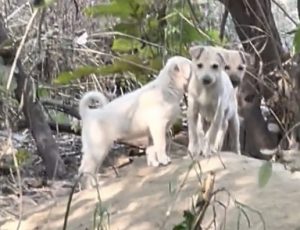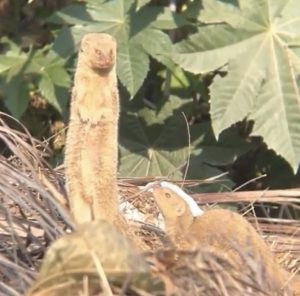
Western UP (IN) – Urban Mammals (Nilgai, Rhesus Macaque, Indian Crested Porcupine, Small Indian Mongoose, Five-striped Palm Squirrel)
Uttar Pradesh (UP) is the most populated state in India, with a population close to 2/3 that of the United States compressed into an area similar in size to the UK. During December of 2021, I spent a week in the western part of the state, specifically between the military cantonment of Meerut and rural villages of Modinagar. This is one of the most populous regions in the world, and has been so for thousands of years. No vegetation grows fallow as every available inch of land is used either for construction or cultivation. Yet even here, wild mammals manage to coexist, and often even thrive, in mankind’s world of mud and concrete. Humans have been confirmed in this area since 70,000 years ago. Since then, the region has been subject to human activity as long as the climate was habitable. Even before agriculture, the fertility and richness of the gangetic plains were conducive to semi-permanent settlements. The introduction of agriculture from the west ~8,000 years ago only excaberated the exponential transition to modern society, with of course a storied and dynamic history in between. This means that Indian mammals have lived among us for thousands of years, and in many cases this is evident in their behavior and even physiology. In this report I will review three species which fit the previously mentioned standard, and attempt to provide a short account of their life history in this part of the world, along with some personal anecdotes. I am aware that one of these species, the feral dog, is not necessarily “wild”, although I encourage the reader to look past this notion for the purpose of this report. In a region like this, where human influence has been incessant and increasing since the dawn of recorded time, the term “wild” carries an unorthodox connotation. I myself believe that no animal in this area is truly “wild”, in the literal sense at least. In many regards, these feral dogs behave empirically “wilder” than many other “wild” mammals of the region. Feral Dog – Canis lupus (familiaris): While searching for birds in a small (no more than an acre) barbed-wire-fenced Phragmites savanna and sewage outflow (soon to be developed into military housing), I flushed a group of three stray dogs, including nursing female, from sleep in a patch of tall grass on several occasions. They were visibly aggravated at my presence, especially the large male, who expressed his displeasure by barking and following me, a clear sign of a den in the vicinity shown by most Canis. The next day, I found the den of these stray dogs, home to four puppies all identical in appearance with exception of age and coat shade, ranging from cream to tan. Classic dingo-like phenotype seen in all feral dogs after several generations removed from domestication. Watched them for a long time from a close but concealed position so as to not stress the adults who were nearby, but not in the direct vicinity of the den. Play behavior and naive curiosity just like what I have observed in Red Fox (Vulpes vulpes) kits. Mother made one trip back to den to nurse in the time I was watching, feeding frenzy ensued as expected but not as rough as I have seen in red foxes. When the mother had finished and began to leave they followed her into the meadow begging for more but were promptly chased back into safety of the trees. The mother then joined her mate below the neighborhood dumpster, and watched as he leapt 1.5 meters to a small hole in the top and shortly after emerged with some roti scraps.  While observing all this, it was interesting to consider how for much of our early human history dog-like wolves plausibly looked and behaved just like these strays. Lots of evolutionary research supports that in some instances, it was the wolves who ultimately “domesticated themselves” by tolerating humans enough to approach us and scavenge on the outskirts of our settlements. Even in the earliest known remains of what can be called dog-like wolves, before evidence of a social relationship with humans, the skull and canine size was reduced and stature was less lean muscle and more like what is seen in todays stout bodied mutts. These are all considered adaptations for scavenging, as with a steady supply of human scraps the wolves bold enough to take advantage of this food source no longer had a need for killing canines, energy-draining complex brains to coordinate hunts and an athletic build to take down megafauna. These feral dogs now occupy the ecological niche of a mesocarnivore, the same role taken by golden jackals in more remote parts of India (which have been outcompeted by strays in much of their range) and foxes/coyotes in America. Although I often see the transformation from wolf to dog, along with simultaneous drop down the food chain, as a shame on the species, one has to consider the success feral dogs have had here – there are at least a billion in the country – as opposed to wild wolves, the nearest populations of which are barely clinging on in the arid aravalli ranges and high Himalayas. This wolf-dog complex demonstrates the idea I’ve had that in the near future, mesocarnivores will take over the world. Gone are the days of Pleistocene predatory marvels like 12-foot-tall short-faced bears and buffalo-sized ngandong tigers; mankind simply cannot coexist with such apex predators and obligate carnivores. Mid-sized generalists like coyotes, jackals and feral dogs which can fall back on an omnivorous diet and are not large/aggressive enough to warrant extreme fear/persecution from people are the new wave of successful predators on earth. And in my opinion, no meso-predator is better suited to thrive in the shadows of our societies than the one that has been doing it for the entirety of its existence, the mongrel dog. Indian Crested Porcupine – Hystrix indica This savanna was also home to a small society of porcupines. On my first night shining, I spotted six individuals including a juvenile and three large adults. They emerge after sunset to lick salt from roadway. These creatures have a famous craving for salt. I later found a quill in the garden, which I probably illegally smuggled back to the states. The next day, while exploring the interior of the small savanna, four crested porcupines were startled out of hiding, two only heard as they fled and just the tips of quills moving through grass visible on another but the last very large porcupine was seen well at close range in full sunlight; quills down as he made a quick retreat so the animal was surely in flight mode, not seeking to defend. I was initially worried about encountering one as I walked along their game trails and over their grass tunnels but these are timid creatures and would much rather flee than risk encountering a human, despite their intimidating weaponry. I am curious about their relationship with the feral dogs, likely one of mutual respect & avoidance. These porcupines occupy a hypocarnivorous niche here, like a cross between raccoon and groundhog. Traits including a generalist diet to find food anywhere, ability to dig shelter from the elements (namely the monsoon), nocturnal habits to avoid people and deadly defense mechanism to deter predators enable this animal to thrive in developing India. Small Indian Mongoose (Herpestes javanicus): Colony of 4-5 small Indian mongoose found in dirt mound next to dump yard. Skittish little carnivores, but their curiosity could be exploited through kissy squeaky noises which mimic a wounded prey animal. These noises even attracted an accipiter (likely Shikra). When startled they dive into their tunnels and peek out, if the threat is still present they disappear and emerge 10 feet away so there must be an elaborate tunnel network underground, almost certainly excavated by a porcupine. A few days later, I took some time to thoroughly observe this small colony. At first wary but they quickly accepted my presence. Social dynamics having vague similarity to a small lion pride, colony composed of one large older grizzled male, three small female and one younger male. Difference in size and build is clear between sexes. Observed bigger male mating many times with one female. Also lots of play behavior between these two (perhaps a dominant pair like in wolves). Female playfully trying to catch butterfly. Male chased after palm squirrel sending it screaming into the trees, and was inches away from catching it. A shame; this would have been an interesting clash to witness. But I suspect it was more territorial and not a genuine hunting attempt. Mongooses ignoring birds like ashy prinia, black redstart and Indian robin which would approach well within striking range. Maybe they are lazy because primary food source is the garbage dump.
While observing all this, it was interesting to consider how for much of our early human history dog-like wolves plausibly looked and behaved just like these strays. Lots of evolutionary research supports that in some instances, it was the wolves who ultimately “domesticated themselves” by tolerating humans enough to approach us and scavenge on the outskirts of our settlements. Even in the earliest known remains of what can be called dog-like wolves, before evidence of a social relationship with humans, the skull and canine size was reduced and stature was less lean muscle and more like what is seen in todays stout bodied mutts. These are all considered adaptations for scavenging, as with a steady supply of human scraps the wolves bold enough to take advantage of this food source no longer had a need for killing canines, energy-draining complex brains to coordinate hunts and an athletic build to take down megafauna. These feral dogs now occupy the ecological niche of a mesocarnivore, the same role taken by golden jackals in more remote parts of India (which have been outcompeted by strays in much of their range) and foxes/coyotes in America. Although I often see the transformation from wolf to dog, along with simultaneous drop down the food chain, as a shame on the species, one has to consider the success feral dogs have had here – there are at least a billion in the country – as opposed to wild wolves, the nearest populations of which are barely clinging on in the arid aravalli ranges and high Himalayas. This wolf-dog complex demonstrates the idea I’ve had that in the near future, mesocarnivores will take over the world. Gone are the days of Pleistocene predatory marvels like 12-foot-tall short-faced bears and buffalo-sized ngandong tigers; mankind simply cannot coexist with such apex predators and obligate carnivores. Mid-sized generalists like coyotes, jackals and feral dogs which can fall back on an omnivorous diet and are not large/aggressive enough to warrant extreme fear/persecution from people are the new wave of successful predators on earth. And in my opinion, no meso-predator is better suited to thrive in the shadows of our societies than the one that has been doing it for the entirety of its existence, the mongrel dog. Indian Crested Porcupine – Hystrix indica This savanna was also home to a small society of porcupines. On my first night shining, I spotted six individuals including a juvenile and three large adults. They emerge after sunset to lick salt from roadway. These creatures have a famous craving for salt. I later found a quill in the garden, which I probably illegally smuggled back to the states. The next day, while exploring the interior of the small savanna, four crested porcupines were startled out of hiding, two only heard as they fled and just the tips of quills moving through grass visible on another but the last very large porcupine was seen well at close range in full sunlight; quills down as he made a quick retreat so the animal was surely in flight mode, not seeking to defend. I was initially worried about encountering one as I walked along their game trails and over their grass tunnels but these are timid creatures and would much rather flee than risk encountering a human, despite their intimidating weaponry. I am curious about their relationship with the feral dogs, likely one of mutual respect & avoidance. These porcupines occupy a hypocarnivorous niche here, like a cross between raccoon and groundhog. Traits including a generalist diet to find food anywhere, ability to dig shelter from the elements (namely the monsoon), nocturnal habits to avoid people and deadly defense mechanism to deter predators enable this animal to thrive in developing India. Small Indian Mongoose (Herpestes javanicus): Colony of 4-5 small Indian mongoose found in dirt mound next to dump yard. Skittish little carnivores, but their curiosity could be exploited through kissy squeaky noises which mimic a wounded prey animal. These noises even attracted an accipiter (likely Shikra). When startled they dive into their tunnels and peek out, if the threat is still present they disappear and emerge 10 feet away so there must be an elaborate tunnel network underground, almost certainly excavated by a porcupine. A few days later, I took some time to thoroughly observe this small colony. At first wary but they quickly accepted my presence. Social dynamics having vague similarity to a small lion pride, colony composed of one large older grizzled male, three small female and one younger male. Difference in size and build is clear between sexes. Observed bigger male mating many times with one female. Also lots of play behavior between these two (perhaps a dominant pair like in wolves). Female playfully trying to catch butterfly. Male chased after palm squirrel sending it screaming into the trees, and was inches away from catching it. A shame; this would have been an interesting clash to witness. But I suspect it was more territorial and not a genuine hunting attempt. Mongooses ignoring birds like ashy prinia, black redstart and Indian robin which would approach well within striking range. Maybe they are lazy because primary food source is the garbage dump.  Thanks for reading – hope you enjoyed and/or learned from my first mammal watching post – Adit
Thanks for reading – hope you enjoyed and/or learned from my first mammal watching post – Adit
Post author
3 Comments
Leave a Reply
You must be logged in to post a comment.


amielhopkins
This shit fire